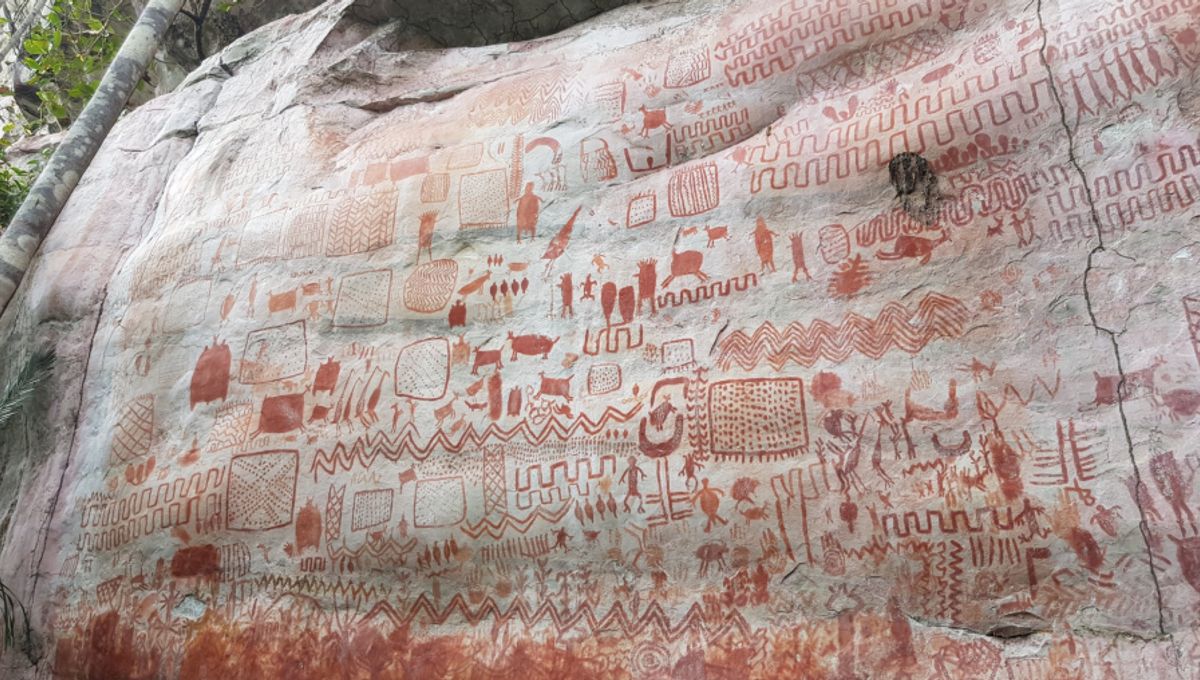
Arguably the most impressive example of prehistoric rock art ever discovered has finally been interpreted, and the meanings behind the images are truly mind-blowing. Collaborating with Indigenous elders in the Colombian Amazon, researchers learned that the epic collection of ancient paintings alludes to a hidden spiritual dimension that shamans are able to navigate by transforming into animals.
The jaw-dropping artworks cover a 19-kilometer-long (12-mile) sandstone outcrop known as the Serranía de la Lindosa, and consist of tens of thousands of illustrations of humans, animals, and mythological beings painted in red ocher. The oldest images are thought to have been created around 11,000 years ago in Colombia’s Guaviare department, yet the presence of paramilitary groups in the region prevented the site from being discovered until 2016.
Beginning in 2018, researchers spent six years attempting to uncover the meaning and significance of the paintings, aided by Indigenous elders from the local Tukano, Desana, Matapí, Nukak, and Jiw communities. It was thanks to this collaboration that the authors of a new study were able to discern the hidden messages behind the ancient artworks.
“Indigenous descendants of the original artists have recently explained to us that the rock art motifs here do not simply ‘reflect’ what the artists saw in the ‘real’ world,” said study author Professor Jamie Hampson in a statement. “They also encode and manifest critical information about how animistic and perspectivistic Indigenous communities constructed, engaged with, and perpetuated their ritualized, socio-cultural worlds.”
As one Matapí ritual specialist named Ulderico explained to the researchers, if you want to understand what the images mean, “you have to look at [the motifs] from the shamanic viewpoint.”
According to the authors, Indigenous Amazonian cosmology is based on a concept that anthropologists call New Animism, whereby “each living being’s physical body can be imagined as an ‘outer cover’ (or ‘clothing’) hiding its human form”. To interact with the true essence of other beings, shamans ritualistically shed their own superficial coverings and enter a spiritual realm in which the boundaries between species are blurred.
For instance, shamans are often conceptualized in jaguar form while navigating the supernatural dimension, where they can access the knowledge and spiritual power that the animal hides beneath its physical exterior. “The Desana word yee, for instance, means both jaguar and shaman – and there are numerous ethnographic examples in the Amazon of ritual specialists transforming into jaguars,” explain the researchers.
“We argue that the rock art here is connected to ritual specialists negotiating spiritual realms, somatic transformation, and the interdigitation of human and non-human worlds,” they continue. This interpretation is supported by the large number of scenes depicting therianthropic transformations, whereby humans are endowed with animal features, as if morphing into snakes, jaguars, or birds.
“The Tukano, Desana, Matapí, Jiw, and Nukak speakers who accompanied us to the rock art sites highlighted these images, discussing the fluid transformation between animal and human states,” write the study authors.
According to Hampson, this incredible collaboration marks “the first time that the views of Indigenous elders on their ancestors’ rock art have been fully incorporated into research in this part of the Amazon.”
“In so doing, it enables us to not simply look at the art from an outsiders’ perspective and guess,” he said. “It enables us to understand that this is a sacred, ritualistic art, created within the framework of an animistic cosmology, in sacred places in the landscape.”
“It also emphasizes how Indigenous belief systems and myths need to be taken seriously.”
The study is published in the journal Arts.
Source Link: Dazzling Ice Age Amazonian Rock Art Depicts Shamans Spiritually Transforming Into Animals